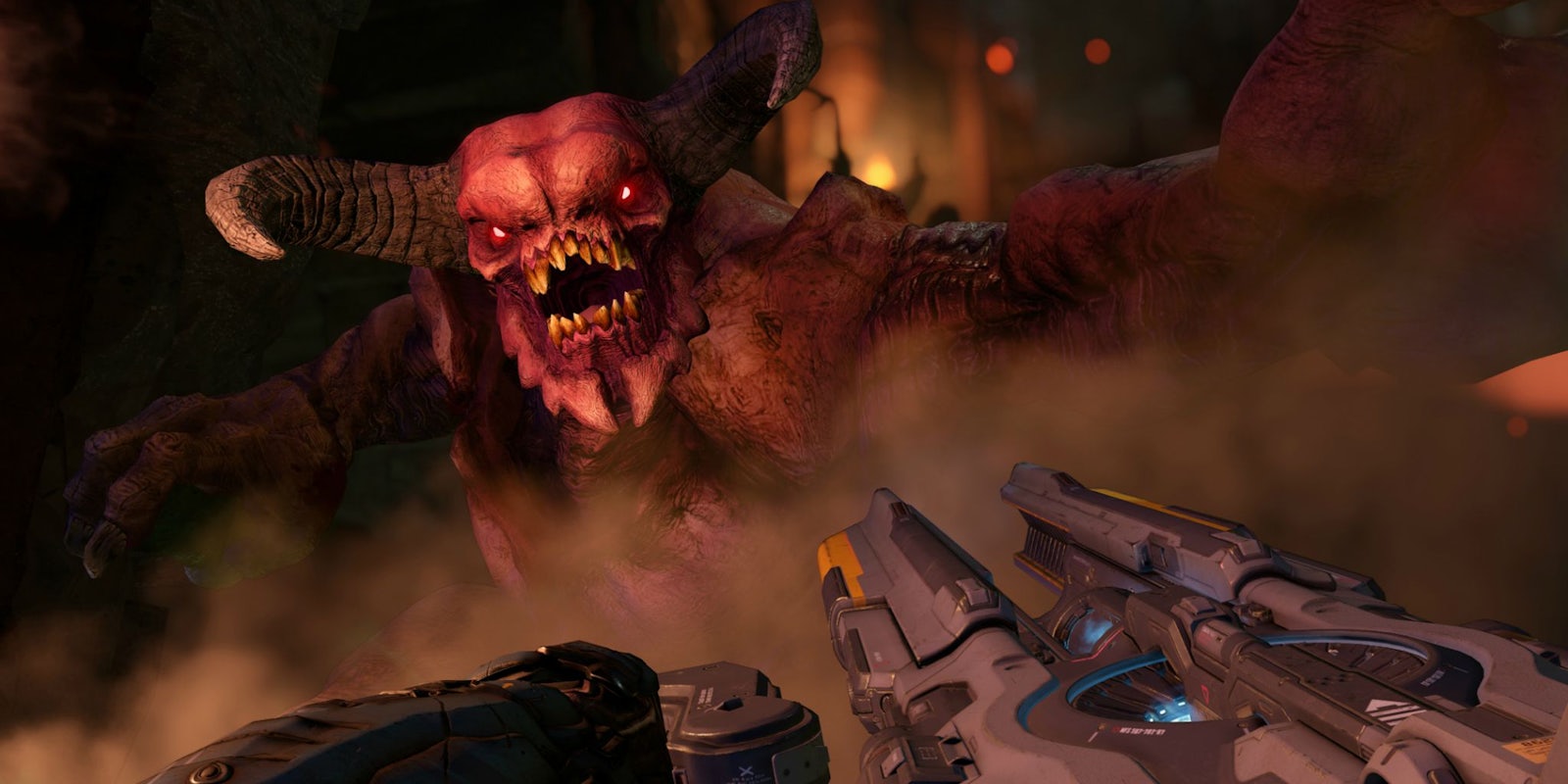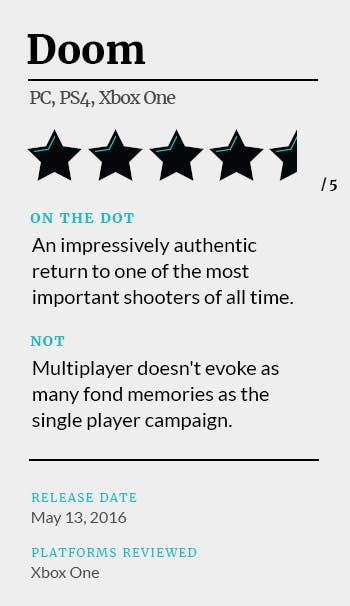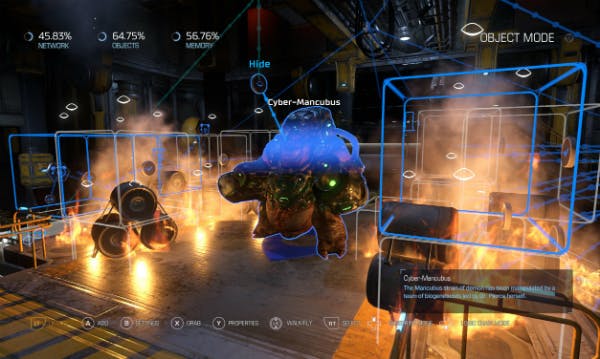At some point around the 20th time an Imp from Hell ripped my arm out of its socket and beat me to death with it, I made peace with just how brutal the new Doom is.
Id Software’s previous attempt at a Doom reboot, Doom 3, released in 2004, followed the classic Doom storyline but missed the mark in terms of authenticity. Doom 3 focused too much on horror and not enough on the fast pace and action that made the original Doom a massive hit. The insectoid, David Cronenberg-esque demon designs of Doom 3 evoked the original monsters but didn’t capture their essence.
The new Doom, on the other hand, feels completely authentic. The first time a Doom veteran sees the present-day versions of a 20-foot-tall Baron of Hell looming with brown satyr legs and huge goat horns, or a giant, red, floating Cacodemon with one huge eye and a gaping maw that could fit their entire body, that Doom veteran will probably feel the echoes of old fear. These are the Doom monsters we remember.
Players in 1993 learned quickly that the only way to survive Doom was to be as nakedly aggressive as possible, to clear rooms of possessed soldiers and demons and other Hellspawn as rapidly as they could, to slaughter everything before it had a chance to hurt you.
This perfectly describes the new Doom, as well. If you stop moving, you’re dead. If you take too long to select your weapon, you’re dead. Any indecision will lead to a wet, chunky, spattering end. Doom is not a game for casual players. It will punish you. It will demand your respect and if you fail to give it, you will wind up a crumpled, bloody pile on the floor while Imps beat you to death with your own limbs.
What surprised me about Doom was the degree to which its story was the animating force behind how voraciously I devoured the campaign. Things have already gone to hell on Mars when Doom begins, because in this retelling of the mythology, teleportation research didn’t accidentally open a gateway to Hell.
In this story the United Aerospace Corporation is perfectly aware of the existence of Hell. In fact, the company has been tapping into the energies coursing through it to power human technology. When demons invade the base, doors are locked down as a public address announcement declares “Demonic presence at unsafe levels,” because minor infestations are apparently part of an ordinary day in UAC research on Mars.
As in Doom 3, a crazed scientist is responsible for the demons getting loose, and a high-ranking member of UAC is trying to seal the demons back into Hell, but what begins as a secret this time around is who you are. You’re no longer just “the lone Marine trying to save humanity,” as in every previous Doom game.
If you stop moving, you’re dead.
You’re given every reason to think that you might not actually give a damn about people. You have some deep connection to the demons running amuck. They fear you, for good reason. And trying to figure out who this Doom Marine was kept me motivated to slog through one of the toughest first-person shooter games I’ve played.
I’m tempted to buy a copy of Doom on PC, because it must look glorious. It feels like a game meant for a high-powered gaming rig. Textures can take a noticeable time to load on the Xbox One version. Load times between deaths and respawns are just long enough to be frustrating, especially when you die a dozen times in a row and are itching for your next attempt to defeat whatever menagerie of demons just butchered you.
Once you’re in the game, however, it runs smooth as silk no matter how many enemies and explosions or how much gore is filling the screen. You may as well be gliding around the maps for how smoothly Doom runs, and that makes it easier to get into the state of flow you need to be in to pass through some of Doom’s toughest fights.
You don’t have regenerating health and shields in Doom. Being fleet of foot lets you stay ahead of the enemy when you’re on the verge of death and need to grab a handful of medpacks, and pieces and shards of armor, just like the good old days.
Speed is also your saving grace when it comes to landing glory kills: gory finishing moves where you stomp skulls, rip off parts of a demon’s anatomy and shove them down said demon’s throat, snap off a demon’s horn and stab it in the head, etc.
When these disgusting finishing moves were shown off in Doom’s announce trailer, it was easy to dismiss them as needless gore meant only to bolster Doom’s reputation as a shockingly violent first-person shooter (how the 1993 original was received by frightened parents’ groups).
Glory kills are actually a key component of smart, tactical play, because any monster destroyed by a glory kill is more likely to drop health and ammo packs than a monster you finish off with a bullet.
You can only execute a glory kill on a demon that is stunned, and demons get stunned when they are very close to death. Softening up demons and keeping them around in order to save a quick glory kill for later can be the difference between finishing a fight or meeting a grotesque death and reloading to the previous checkpoint. But saving demons for glory kills also leaves one more monstrosity chasing you around the room, slavering for your blood.
Trent Reznor composed the music for Quake, the shooter franchise developed by id Software following the release of Doom 2, and there’s a tremendous amount of this musical DNA in the new Doom. When refrains of distorted, guitar-heavy, synthesizer-laced industrial music bite into the soundtrack, it sounds like something out of the Nine Inch Nails catalog—and to great effect.
Doom’s map design also hails back to the glory days of the 1990s, before the dawn of the maligned “corridor shooter” that places the player at Point A and tasks them with running through a defined, unerring path until they arrive at the end of the level, Point B. You will be using the map function in Doom if you don’t want to get lost, and especially if you want to uncover all the game’s hidden rooms and secrets.
The flip side of old-school map design is old-school frustration at not being able to figure out where to go. It’s ironic that a game like Doom that stresses speed can slow itself down to a crawl when the path forward isn’t easy to discern.
The map helps, and the way forward is usually marked with green lights that blend naturally into the environment versus looking like obvious signposts, but, especially in the early levels, I spent too much time figuring out where I needed to be instead of killing demons in lightning-quick firefights. Doom also occasionally bogs itself down in boss fights that feel out of place.
Doom’s multiple customization systems are a nod to contemporary standards. Salvaging armor components from fallen soldiers can upgrade your Praetor Suit’s mapping systems, improve its resistance to explosive damage, and increase the effectiveness of powerups like Quad Damage boosters (another Quake reference).
You can unlock two modifications for each of your main weapons and pass weapon challenges to earn upgrade points to enhance those mods. Rune challenges transport you through extra dimensional portals where you can complete trials and unlock Runes that change your combat performance. Finally, you can unlock upgrades to increase your maximum total health, armor, or ammunition.
The more familiar you are with the original Doom and Doom 2, the more these concessions to modern design standards will be recognizable as concessions. The same goes for Doom’s multiplayer design, but in this case the blending of old and new doesn’t work as much in Doom’s favor.
Doom’s multiplayer modes take some cues from the past. Health still doesn’t regenerate so you’re still grabbing medpacks and armor shards. Controlling weapon and powerup spawns are keys to victory. No one will be lying in wait to set ambushes as in Call of Duty, and snipers that try to pick a spot and wait are also likely to get shot in the back. Doom’s multiplayer levels are full of boost pads and teleportation portals. These are clearly maps designed to keep players on the move at all times.
Death is also as brutal in Doom multiplayer as in the campaign. You will more often than not wind up as a pile of bloody chunks on the ground, as if every weapon was designed explicitly for the purpose. Life is cheap, and respawns are quick.
The underlying tone of Doom multiplayer feels like a throwback to simpler days, but then all the modern conventions creep in like customizable weapon loadouts, Hack Modules that provide temporary ability bonuses, and unlocking new weapon and equipment options by leveling up your character.
I never played on a map that didn’t feel competitively balanced, and the maps set in Hell are gorgeous to look at. Team scores were almost always tight throughout the course of a match no matter what match type I was playing, this being a hallmark of well-tuned multiplayer design. But while I have nothing to criticize about Doom’s multiplayer, I also have nothing to commend.
Life is cheap, and respawns are quick.
Most of Doom’s multiplayer match types are the predictable litany, variants of Deathmatch and Domination. The match type I enjoyed the most was Freeze Tag, where when you freeze an enemy in ice to “kill” them, and the goal is to freeze the entire team to end the round. You can thaw out friendly players, and this led to some fun reversals where I thought we had the match wrapped up, but a lone enemy managed to thaw out most of his team.
Powerups called Demon runes appear in most matches. They temporarily transform the player into one of four different varieties of demon. The runes add a unique, Doom-themed element to multiplayer matches, but what really makes Doom multiplayer interesting for me is SnapMap, an easy-to-use map editor that allows you to upload maps to share with the community and download other peoples’ maps to play on them.
Think of SnapMap as Super Mario Maker for the hardcore shooter crowd. Just like Fallout 4 on console will eventually include player-built mods, Bethesda Softworks is trying to bridge the gap between the PC and console worlds by taking Doom modding, a practice that’s still going strong most notably with the release a few years ago of Brutal Doom, and bringing it to consoles.
The complexity of SnapMap—it includes the ability to set up logic chains, control AI behavior, and other tools that allow for serious FPS map design—is what prevents me from thinking of Doom’s multiplayer as an obligatory addition. What I was reminded of while playing Doom multiplayer was how refreshing it felt when Wolfenstein: The New Order bucked convention and didn’t include a multiplayer mode.
Doom’s single-player campaign offers elements that are often rare in modern shooter design, ideas that maybe should never have been left behind as the FPS genre evolved. The multiplayer shooter design elements that have been left in the past, on the other hand, might best be left in the past. To the untrained eye, FPS games are as bluntly violent as they’ve always been, but the experienced player and observer knows that modern multiplayer shooters are just as defined by tactical complexity and the nuances of class balance as they are by guns and explosions.
As much as I’m interested in what the Doom community creates with SnapMap, I can’t see myself sticking with Doom’s multiplayer long enough to find out. I do see myself going back to discover all the secrets I missed in the campaign the first time around, or trying higher difficulty levels if I can steel myself to the punishment I’ll have to take as a result.
Score: 4.5/5
Disclosure: Our Xbox One review copy of Doom was provided courtesy of Bethesda Softworks.


